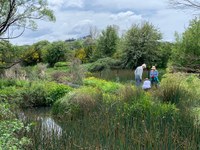Non-destructive revegetation project
The point of our ‘non-destructive revegetation’ trial is to demonstrate whether native plants can be re-established without first destroying an existing riparian forest of non-native species (including: willow, hawthorn, and poplar). We came to this approach because the Flood Creek riparian forest currently supports a number of different native animals species, which would be displaced if a typically 'destructive' approach were enacted. Our project is showing good results so far and could be widely adopted where non-native vegetation provides habitat to populations of native species.
Strangely, it feels like a subversive act to be planting native trees without killing all of the existing non-native ecology first because large sums of government funding is regularly expended on willow (and other weed) removal throughout southeast Australia. Occupied riparian forests are regularly poisoned and bulldozed at tax-payer expense.
As our non-destructive revegetation trial continues we hope to demonstrate to existing land management authorities and funding bodies that when your goal is to increase diversity and promote improved ecosystem function, the destruction that precedes most 'revegetation' projects is unnecessary and counterproductive. It is better to add species-components to these systems to boost their complexity, rather than attempting to purify them by purging all organisms considered foreign.
The point of our project is to highlight the excesses of nativist ideology in land management by demonstrating the capacity for natives and non-natives to co-exist and the potential to augment diversity without returning to an ecological bare-ground first. No only is our approach more ecologically friendly, it is also much cheaper; it avoids ecological disturbance; creates no erosion, and uses no herbicides near disturbed waterways.
We look forward to sharing the results of our work as the project continues into the future.





